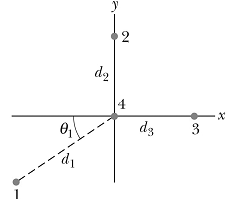1. In the figure below, q1 = -2e, q2 = +2e, q3 = +4e, and q4 = +2e, where e is the elementary charge. Charge q4 is located at the origin, while q2 and q3 are each a distance d2 = d3 = (2d)/3 from the origin. Charge 1 is a distance d1 = d from the origin. The dashed line connecting charge 1 and charge 4 makes an angle θ1 with respect to the negative x direction. Our goal is to find the net electric force on charge q4.

a. Let F41 be the force that q1 exerts on q4, �F42�� be the force that q2 exerts on q4, and F43 ��be the force that q3 exerts on q4. Draw vectors on the figure above that indicate the direction of each of these three forces (i.e. draw a free body diagram).
Remember to label each vector.
b. Determine � �F41 ��, �and �F42, F43��,�� in unit vector notation. Put your answers in terms of d, θ1, and physical constants.
c. Determine the net force ��exerted on q4 in unit vector notation. Put your answer in terms of d, θ1, and physical constants.
d. Determine the magnitude of F4. Put your answer in terms of d, θ1, and physical constants.
2. In the figure below, a non-conducting rod has a length L and a charge -q uniformly distributed along its length. Point P is a distance a from the right edge of the rod. Our goal in this problem is to find the electric field (both magnitude and direction) at point P. Assume that positive x is to the right.

a. What is the direction of the electric field at point P?
b. Determine the linear charge density. Put your answer in terms of q, L, a, and physical constants.
c. Determine the electric field �� due to a differential element of width dx, that is located a distance x from the left side of the rod. In other words, x = 0 at the left side of the rod. Put your answer in terms of q, L, a, x, dx, and physical constants.
d. Integrate to determine the net electric field at point P due to the entire rod. Put your answer in terms of q, L, a, and physical constants.
e. What is the electric field at point P if a is much larger than L? Let a → ∞ and determine the electric field using your answer from part d. Put your answer in terms of q, a, and physical constants. What type of charge distribution does the rod behave like when a is much larger than L?